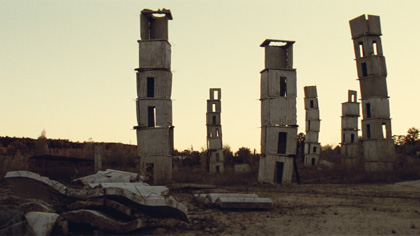Primary navigation

United Kingdom/France/The Netherlands 2010

Reviewed by Lisa Mullen
Our synopses give away the plot in full, including surprise twists.
Barjac, southern France. The film follows artist Anselm Kiefer as he works in the installation complex he has created around his studio in the countryside. Opening with a slow, meditative tour around labyrinthine corridors, tunnels and concrete structures, it takes the viewer through a mysterious space resembling an archaeological dig, filled with what appear to be the fragmented relics of a lost civilisation. As the camera moves through various parts of this ongoing art project, we see sculptural concrete forms, pools of smashed glass and stacks of large ‘books’ made from thick layers of lead sheeting, all of which appear ancient, weathered and broken. The central part of the film, which shows Kiefer making the work and directing his assistants, reveals that this ageing process is a key part of his practice, involving much digging, breaking and melting of materials.
Kiefer is filmed in conversation with a German journalist, describing how he hopes the ageing process will continue as the work is exposed to time and the elements. Finally, the camera takes another tour of the installations, this time pulling back to reveal the effect of the work at the level of landscape, with large structures framed against an evening sky.
Is this a film about art, or about film as art? That’s the question asked by Sophie Fiennes’ ravishing, hypnotic record of the work of Anselm Kiefer.
Kiefer’s practice depends on a large-scale perspective that isn’t easily placed within the neat rectangle of a cinematic frame. He has created a huge complex of installations spreading across the landscape around his atelier in Barjac, southern France, and the structures he creates, which rise out of the ground like the ruins of a lost city, invite a long view of time as well as space, since they are intended to weather and collapse as the years pass. Fiennes’ film, on the other hand, begins with sepulchral intimacy and timelessness, with the camera roaming down long, mysterious corridors like Theseus on the trail of the Minotaur, in a subterranean world where pot shards rest in the dust like archaeological relics and the claw marks left by machine-digging resemble the traces of a terrifying feral encounter. When we finally stumble into the light and discover a human being, he is tending a furnace, one of the most primal technologies known to man, though he is in fact a harbinger of modernity: his ancient activity will introduce the film’s middle section, in which Kiefer’s practice is brought down to its dusty, noisy, industrial brass tacks, and it’s the human artist, not some mythical monster, who is gouging and tearing the earth.
Kiefer’s work repeatedly references images specific to the Holocaust (gold teeth, shower heads) as well as more general war detritus (including the twisted remnants of reinforced concrete which suggest the World Trade Center without categorically insisting on a connection). But he isn’t engaged in a simple act of memorialisation, or not only that. By building ‘new’ ruins, and burying freshly made relics in freshly dug caves, he is thinking through the artificiality of history, of memory, which remakes as it retells, and leaves its own traces even as it reads the traces of what has gone before. In an interview with a German interviewer, Kiefer references Heidegger, but it’s Walter Benjamin’s thought that underlies much of his practice: Kiefer’s work is an exposé of the intimate connections between the modern cityscape and the topography of ruins that coexists beneath its surface, and it’s also an attempt to map the constellations by which these historical portals can be navigated.
As so often with conceptual art, the relationship between work and practice is where meaning resides. As an immersive installation, Kiefer’s wonderland is an eerie place filled with spectral forms and numinous intimations of death; only by showing the industrial process by which it has been built – the roar of the diggers, the smashing of glass, the thumping and spilling and dropping and dirtying by which the appearance of history has been manufactured – can it be revealed in all its self-critiquing complexity.
Fiennes does this, beautifully, and she does something more; she places the artist in a new frame, one of her own devising. Twitching away the curtain of artistic illusion, she reveals Kiefer and his assistants choked, coated and physically subsumed by the materials they work with as they turn art into a kind of theatre. The interdependence of the aesthetic and the artisanal will always be of interest to film-makers, whose work depends on technique and technology as much as inspiration and concept; in highlighting Kiefer’s ambivalent status – is he a curator, a producer, a forger, a conductor? – Fiennes is also thinking about film’s artificial authenticity and its inability to tell ‘the truth’. Finally, slyly, she appropriates Barjac itself for her own ends, concluding the film with a lingering shot of Kiefer’s strange, tottering towers framed against a yellow sky – a surrealist film set, waiting expectantly for the actors to walk into shot.
Sophie Fiennes talks to Isabel Stevens on page 11 of the November issue of Sight & Sound
The tracks of time: Sarah Turner talks to Sophie Mayer about Perestroika, her Siberian train travelogue to the end of the world (online, August 2010)
The deathly hallows: Mat Collishaw tells Isabel Stevens about Armenian shrines, YouTube sheep sacrifices and Retrospectre, his homage to the strange world of Sergei Parajanov (online, March 2010)